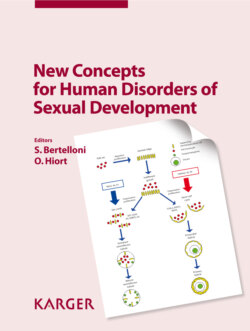Читать книгу New Concepts for Human Disorders of Sexual Development - Группа авторов - Страница 24
На сайте Литреса книга снята с продажи.
Primordial Germ Cells
ОглавлениеBy the end of the 5th week pc of human embryonic development, 3 different lineages of somatic cell types with bipotential fate, dependent on their future paths (see below), are forming the gonadal anlagen. At this stage, immigrating PGCs are colonising the gonadal structures. After they have permanently been situated in the gonad, they are specified as gonocytes. The PGCs differentiate from epiblast-derived stem cells in the yolk sac. Due to their expression of molecular and cellular markers for pluripotency or early germ cells such as alkaline phosphatase, OCT3/4 and c-kit, they can be distinguished from other cells within the forming gonad (see also table 2 and online suppl. table 1). Guided by extracellular matrix proteins expressed along the dorsal mesentery of the hind gut, the PGCs migrate to the gonadal ridges. During this phase, PGCs exhibit active mitotic proliferation and have expanded in numbers while reaching the gonadal anlagen [Bendel-Stenzel et al., 1998; Wylie, 1999]. In the early testis shortly after determination, gonocytes will continue their mitotic proliferation and then become mitotically quiescent. They will not be recruited into meiosis until much later in time. The decision to enter into meiosis or not is thought to be governed by somatic cells in the male gonad since XY PGCs residing in an ovary follow the female path [McLaren and Southee, 1997]. However, meiotic entry might also be activated by mechanisms intrinsic to germ cells [Morelli and Cohen, 2005]. In males, the absence of germ cells still allows differentiation of somatic cells including Leydig cells with steroidogenic activity. Affected males will undergo pubertal development but are infertile due to a Sertoli-cell-only syndrome.
